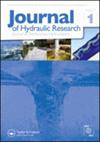Experimental investigation of the hydrodynamic field around a half-cone woody debris jam on a bridge pier
IF 1.7
3区 工程技术
Q3 ENGINEERING, CIVIL
引用次数: 0
Abstract
ABSTRACTA debris jam causes extra load and associated scour on a bridge pier, and this significantly affects the safety of the bridge. Laboratory experiments were conducted to investigate the flow field around half-cone shaped debris jams of equal size, following the geometry in previous field studies, but with different surface roughness. The debris jams were assembled using dowels or by 3D printing. The results indicate three zones were observed behind the debris jam: the wake dead zone, high shear transition zone, and accelerated high-speed zone. A debris jam enlarges the dead zone while Reynolds shear stress was greatest in the transition zone for all debris jam cases. Additionally, the drag coefficient of debris jams built by dowels was greater compared with the 3D-printed debris jam, attributed to the debris jam roughness. In summary, debris jams form the wake dead zone behind the pier, increase downward flow in front of the pier, and enhance flow acceleration around the pier, highlighting the potential hazards to bridge safety.Keywords: Debris jamdrag coefficientflow fieldReynolds shearsingle pier Supplemental dataSupplemental data for this article can be accessed online at https://doi.org/10.1080/00221686.2023.2259859.Disclosure statementNo potential conflict of interest was reported by the author(s).Additional informationFundingThe first author would thank the joint financial support provided by the China Scholarship Council and the University of Ottawa. Additional fundings from the NSERC Discovery grants held by Colin Rennie and Ioan Nistor are also acknowledged.桥墩上半锥木屑堆塞水动力场试验研究
摘要碎屑淤塞会对桥墩产生额外的荷载和冲刷,严重影响桥梁的安全。在室内实验中,研究了大小相同的半锥状碎屑堵塞周围的流场,遵循了先前现场研究的几何形状,但表面粗糙度不同。碎片堵塞是用销子或3D打印组装的。结果表明:岩屑堵塞后存在三个区域:尾流死区、高剪切过渡区和高速加速区。岩屑堵塞使死区增大,而在过渡区雷诺数剪应力最大。此外,由于碎片堵塞的粗糙度,与3d打印的碎片堵塞相比,用凿子制造的碎片堵塞的阻力系数更大。综上所述,泥石流淤塞在桥墩后方形成尾流死区,增加了桥墩前方的向下流动,增强了桥墩周围的水流加速度,凸显了对桥梁安全的潜在危害。关键词:碎片堵塞系数流场雷诺兹剪切单墩补充数据本文补充数据可在https://doi.org/10.1080/00221686.2023.2259859.Disclosure网站上获取声明作者未报告潜在的利益冲突。第一作者感谢中国留学基金委和渥太华大学提供的联合资金支持。由Colin Rennie和Ioan Nistor持有的NSERC发现补助金的额外资金也得到了承认。
本文章由计算机程序翻译,如有差异,请以英文原文为准。
求助全文
约1分钟内获得全文
求助全文
来源期刊

Journal of Hydraulic Research
工程技术-工程:土木
CiteScore
4.90
自引率
4.30%
发文量
55
审稿时长
6.6 months
期刊介绍:
The Journal of Hydraulic Research (JHR) is the flagship journal of the International Association for Hydro-Environment Engineering and Research (IAHR). It publishes research papers in theoretical, experimental and computational hydraulics and fluid mechanics, particularly relating to rivers, lakes, estuaries, coasts, constructed waterways, and some internal flows such as pipe flows. To reflect current tendencies in water research, outcomes of interdisciplinary hydro-environment studies with a strong fluid mechanical component are especially invited. Although the preference is given to the fundamental issues, the papers focusing on important unconventional or emerging applications of broad interest are also welcome.
 求助内容:
求助内容: 应助结果提醒方式:
应助结果提醒方式:


